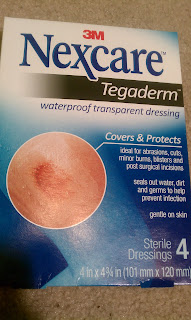Got my bike back from the shop today. Got new handlebars, a new crankset, and the mechanic was able to bend the derailleur hanger back into place. The Purdue club had a practice criterium today, so I was glad to have my bike back to get ready for this weekend at Lindsey Wilson. I got some confidence since I haven't raced in 10 months and also gained some back that I lost from Friday's mishap.
BAM!
I hit the pavement again after the crit when I got back to campus. The pavement changed from concrete to pebble stone during a turn (It had been raining earlier). I didn't feel my rear wheel slipping out from underneath me. I didn't even have time to think, "Oh no. This is going to hurt." All of a sudden I was gliding along... on my hip.
A couple slowed long enough to ask me if I was okay, I said I was alright, and they went along their way. It didn't hurt. It never does immediately. If this happens to you, please stick around for a minute with the injured, and make sure that they are indeed okay. Luckily, I didn't hit my head (I borrowed a friend's helmet) or have other substantial injury, but later the pain from the abrasions was pretty intense.
So, as promised here is some information on abrasion treatment taken from
Essentials of Athletic Injury Management:
"Abrasions are common conditions in which the skin is scraped against a rough surface such as grass, artificial playing surface, floor, or mat. The top layer of skin wears away, exposing numerous blood capillaries. This exposure, with dirt and foreign materials scraping and penetrating the skin, increases the probability of infection unless the wound is properly derided and cleansed.
Immediate Care
It is of the utmost importance to the well-being of the athlete that open wounds be cared for immediately. All wounds, even those that are relatively superficial, must be considered to be contaminated by microorganisms and therefore must be cleaned, medicated (when called for), and dressed. To minimize the chances of infection, it is critical that the wound be cleaned as thoroughly as possible. It is recommended that the wound initially be clean using copious amounts of soap and water or sterile saline. Neither bacterial solutions nor hydrogen peroxide should be used to clean the wound initially. dressing wounds requires a sterile environment to prevent infections.
Dressings
Sterile dressings should be applied to keep a fresh wound clean. Sterile dressings come in various sizes from simple gauze pads to adhesive bandages. Occlusive dressings appear to be extremely effective in minimizing scarring. If a wound is discharging fluid (serum), the dressing should be changed often to minimize bacterial growth. After drainage has stopped, there is no need for a dressing. Antibacterial ointments may be applied to limit surface bacterial growth and prevent the dressing from sticking to the wound. Topical antibiotics are recommended. Wounds may be cleansed with hydrogen peroxide several times daily over the next several days before the reapplication of ointment. Good wound care will minimize the inflammatory response, speed healing and minimize scarring.
Signs of Wound Infection
The classic signs of infection are the same as those for inflammation, including pain, heat redness, swelling, and disordered function. In addition pus may form due to an accumulation of white blood cells, and a fever may occur as the immune system fights the bacterial infection. Most wound infections can be treated with antibiotic drugs. However, in recent years some strains of a bacterium found on the skin call staphylococcus aureus have become resistant to some antibiotics. The bacteria are referred to as methicillin-resistant staphylococcus aureus (MRSA). MRSA stains are much more difficult to treat because many antibiotics do not work. Therefore, infections tend to become more severe than they may otherwise have been if the cause of the infection is not diagnosed early, and antibiotics that no not work are given at first. Infections that start in the skin may spread to cause more serious infections.
Tetanus is a bacterial infection that causes fever and convulsions. A tetanus infection occurs most often with a puncture wound. Tonic spasm of skeletal muscles is always a possibility for any nonimmunized athlete. The tetanus bacillus enters a wound as a spore and, depending on individual susceptibility, acts on the motor end plate of the central nervous system. After initial childhood immunization with a tetanus vaccine, boosters should be given every 10 years. An athlete not immunized should receive an injection of tetanus immune globulin (Hyper-Tet) immediately after sustaining a skin wound."

So, here's what I do:
Wash with soap and water and/or saline wound wash.
Dress with DuoDerm or Tegaderm. Do not use other medications or ointments with this unless directed by your doctor.

Duoderm and Tegaderm are expensive. If you're on the cheap:
There are other
creative cheap solutions with panty hose and maxipads.
Oh yeah, this is why cyclists shave their legs - for road rash treatment and healing. I haven't this year. We'll see.








